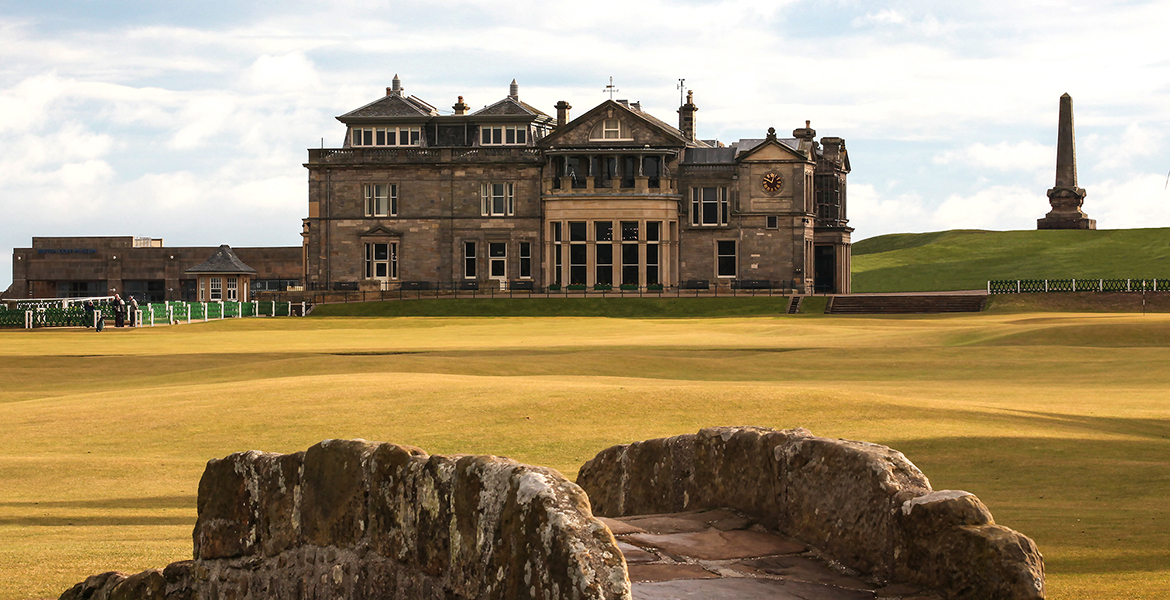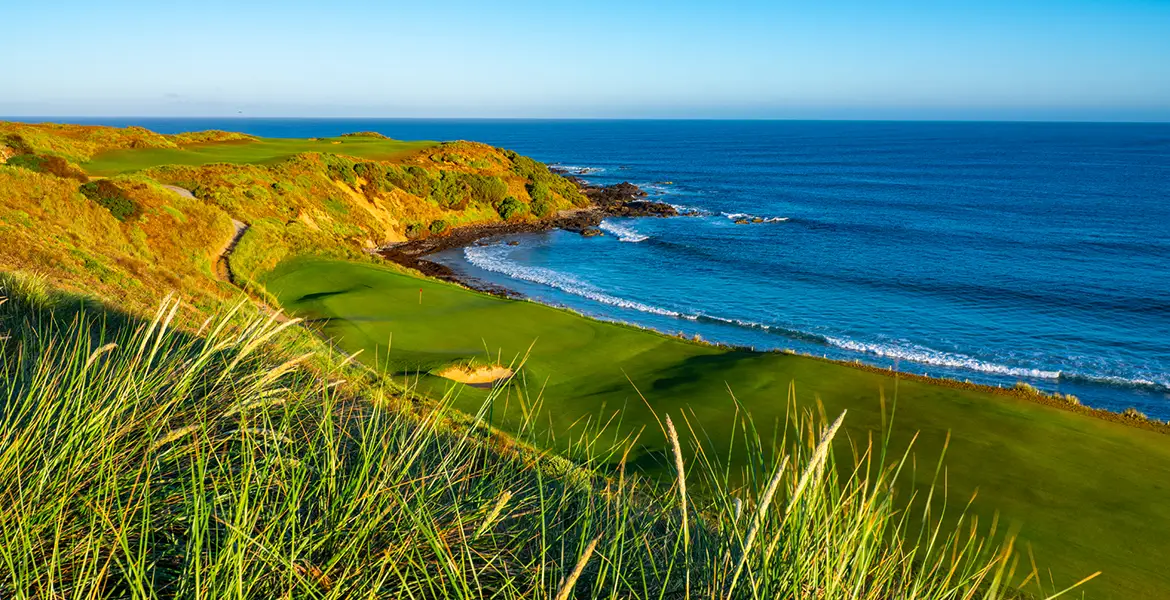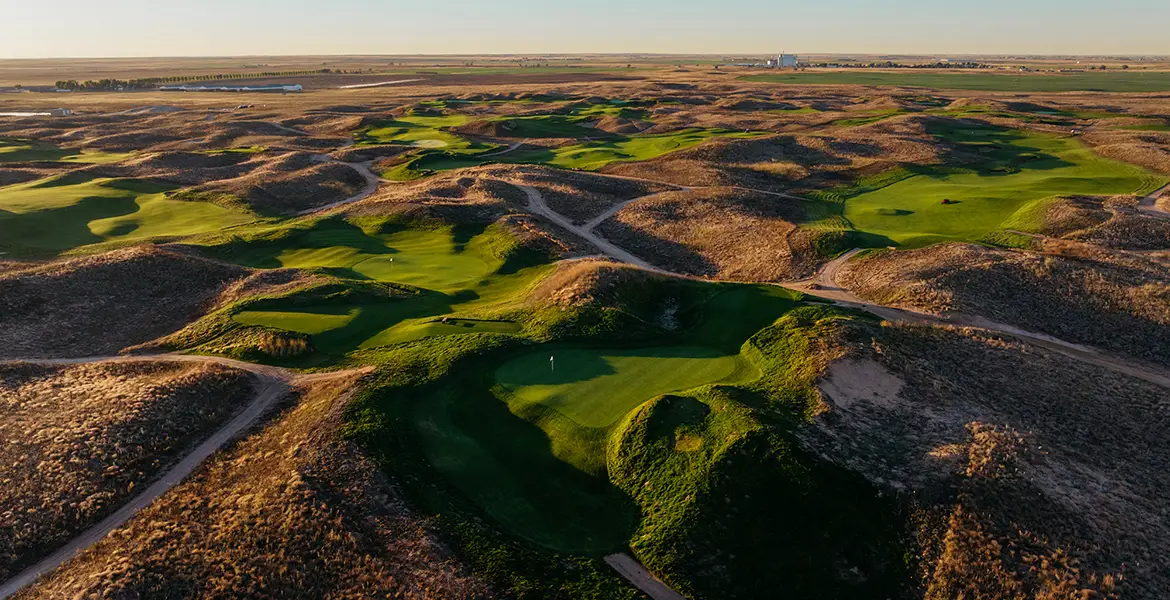By George Peper

Until earlier this year I was barely aware of Wales. I knew it bordered England, in the same quiet, unobtrusive way Canada borders the U.S. I also knew it had its own language, comprised of words that looked like bad Scrabble hands. What I didn’t realize is that it had a collection of links courses to rival the best in Scotland, England or Ireland.
Wales’ links concentrate themselves in the north and south parts of the country, and there’s a lengthy drive between the two poles. As such, the visiting golfer can play the north courses as part of an itinerary that includes the Lancashire coast of England or sample the south courses in combination with a visit to London.
The third option is the full Welsh experience, which is what my wife, Libby, and I did.
About the same size as Massachusetts, Wales resembles the left profile of a pig, with a pair of floppy northern ears and a southwest snout poking into the Irish Sea. Our journey began at the crest of the pig’s pate in the village of Conwy.
Conwy Golf Club is situated spectacularly between Conwy Mountain and the Conwy River, overlooking the Conwy Estuary. (Clearly the local cartographers weren’t long on imagination.) It was founded in 1890 by a group of Royal Liverpool members in search of a holiday course.
When the British Open was held at Hoylake three years ago, Conwy was the championship’s first Welsh qualifying site. I was not surprised to learn that only three players bettered par in that qualifier. The fairways are firm and fast, the bunkers are numerous and grasping, the greens are small, and the wind is constant.
Club captain Tom Prescott guided me around, and I’m glad he did. Although the terrain is fairly flat, the holes zig and zag constantly.
And the course has its quirks. When we reached the 4th hole, eight people were teeing off—in two different directions. No. 4 shares its tee with the 10th. The 8th and 9th holes run parallel to each other, with an internal out of bounds between them, although the white stakes apply only on the 9th hole. Tom didn’t have an explanation for this—presumably you’re allowed to get away with one duck-hooked drive, but not two in a row.
My favorite hole was the 452-yard 5th, the No. 1 handicap hole, possibly because it’s difficult to keep your head down while playing toward the magnificent mountain that backdrops the green. But the truth is that every hole on this course serves up scenery.
“I can’t imagine there is any more spectacular setting for a course in Wales,” I said to Tom as we walked off the 18th green.
“Oh, just you wait, lad,” he said. “Just you wait.”
My wait lasted two hours when we reached Nefyn & District Golf Club. There to greet us were our hosts: Duncan Smith, a fellow journalist, and Janet Brown, a chiropractor and immediate past ladies captain.
Nefyn bills itself as the Pebble Beach of Wales. Virtually every golf-playing nation (even the landlocked ones, it seems) claims to have one such course, but in this case it’s not hyperbole. In fact, in terms of exhilarating, jaw-droppingly beautiful places to chase a golf ball, we might well view Pebble as the Nefyn of America.
The opening par 4 tumbles to the sea, and the four holes that follow it climb along the precipice of a headland—terrain very similar to the 6th through 10th holes of Pebble. We turned inland for the next five holes and after walking off the 10th green, reached a fork in the road.
“The course is actually 26 holes,” said Duncan. “From here on, we can play the new eight or the old eight.
“The new eight’s over there,” he said, pointing inland to a non-descript area that looked like former farmland.
“And where’s the old eight?”
“Out there,” he said, nodding toward the sea. “It’s really not a choice at all,” he said. “You must play the Point.”
Exclamation point might be a better term for the narrow peninsula just large enough for 3,000 yards of breathtaking, occasionally death-defying golf. The holes are not all world class, but the experience emphatically is. If you’ve played Old Head in Ireland, you know what I mean.
At the 14th, a par 3 that plays from an elevated tee down to the farthest edge of the point, Libby uncorked a soaring 3-wood that carried everything, vanishing over the cliff. The name of this hole is “Lifeboat” but Duncan assured us her ball was beyond rescue.
The four finishing holes wend back to the clubhouse while playing perilously parallel to (and almost crossing paths with) the four that preceded them. Later, we were on the clubhouse terrace, beers in hand, enjoying a gorgeous sunset. It had been a long day and my back had acted up, but Janet showed me a stretching exercise that, along with the second beer, worked wonders. The real revelation, though, was the course.
COUNTRY INNS AND DARWIN’S SHAME
Part of the Wales golf experience is the lodging, the best of which are neither big hotels nor modest bed and breakfasts, but something in between: small country-house hotels and inns.
Plas Tan-yr-Allt is a 200-year-old regency-style house that has been modernized by its owners, Nick Golding and Michael Bewick. Set in a wooded hillside above the town of Tremadog, it was once home to the poet Percy Bysshe Shelley.
Dinner had a party atmosphere: cocktails and canapes on silver trays with a half dozen other guests, followed by a four-course meal that ended with coffee, cordials and conversation.
It’s the kind of place you want to stay for several nights, easily justified by the number of fine links in the vicinity. Porthmadog and Pwllheli are nearby, and 30 minutes south is the town of Harlech, home of mighty Royal St. David’s Golf Club.
Surely no Royal course has a more regal setting than this one, with 700-year-old Harlech Castle perched on a cliff above the course, its towers and battlements still intact.
St. David’s is among the top courses in Wales despite a par of 69. It has two par 5s (oddly on consecutive holes, the 7th and 8th) and five par 3s, two of them (oddly again) at the 9th and 18th holes.
By the time I made the turn, I wondered what all the fuss was about. It was a good course, but the terrain was rather nondescript meadowland, and I was wondering whether to join Libby for a tour of the castle instead of playing the back nine.
But then the course heads toward the sea for a rollicking run through the dunes. Suddenly no hole is flat or dull, and every shot is a compelling assignment. The hole that most captivated me was the 15th, a 439-yard dogleg through an ever-narrowing corridor of dunes to a cupped green.
Properly inspired, I came to the 201-yard 18th with a chance to shoot the lowest nine-hole score of my life: I needed birdie for 30. Yes, the par on the back nine is 33. But hey, a 30 is a 30.
Choke mode set in and I two-putted for double bogey. Still, I was glad I hadn’t opted for that castle tour.
Half an hour down the coast is a golf writer’s mecca: Aberdovey, home course of Bernard Darwin, the Cambridge-educated lawyer who became the game’s first literary giant. Of Aberdovey he wrote: “About this one course in the world I am a hopeless and shameful sentimentalist, and I glory in my shame.”
The course was fully booked for the Welsh Boys Championship, but club manager Ian Hamilton took me on a tour. Aberdovey’s lineage includes Harry S. Colt, Herbert Fowler and James Braid, and the layout is in the traditional mold, nine holes out and nine back along a narrow strip of land bordered by the sea on one side and a railway on the other.
I was most taken by the par 3s. No. 12, probably the best-known hole on the course, plays 149 yards to a green perched on a sandhill with out of bounds and the beach just a few yards to the right. Anything short or left will run back down the hill. Ian and I watched a trio of the Welsh boys find the green, to the obvious pride and pleasure of their onlooking parents.
The closing holes run beside the railway and the standout is No. 16, a par 4 of 288 yards in length and about 288 inches in width, leading to a tiny green tucked into the side of a dune. The only sensible way to play this hole is with a mid iron off the tee—unless you’re a teenager.
We watched as another threesome all took big swings with drivers. While none of them found the train tracks, they were struggling to save pars as we moved on.
TIGER’S WATERLOO
Aberdovey is the southernmost stop of north Wales. From here it’s a scenic, occasionally perilous drive of several hours through towns named Neuadd-ddu, Cwmdeuddwr and Ffawyddog to the southern hotbed. Blessedly, Libby was able to limit herself to just two or three gasps of terror as I careened through the narrow, winding roads.
We both needed a drink upon arrival, and the cozy bar of the Great House in Laleston was the ideal place. This restored 16th century farmhouse would be our comfy home for the remainder of the trip.
The Welsh course with which I was most familiar prior to my visit was Royal Porthcawl Golf Club, site of the 1995 Walker Cup. It did not disappoint. Totally exposed to the wind, this is seaside golf at its best, particularly the first three holes, all par 4s that play alongside Cardigan Bay. The Porthcawl fairways are not as humpy as on most links, but they twist and climb constantly.
An unforgettable hole is the 515-yard 5th, bending hard to the left while climbing steeply to a narrow green shouldered by hillocks. But the best is saved for the finishing stretch. Holes 15 and 16 are big, cross-bunkered par 4s playing up and back, one of them invariably into the wind. In a practice round for the Walker Cup, Tiger Woods hit a 360-yard tee shot on the 504-yard 17th then holed his wedge for a double eagle.
However, Porthcawl got him back in his singles match against Gary Wolstenholme. All square on the 18th tee, Woods knocked his second shot out of bounds to lose the match.
Just a couple of miles south is Pyle and Kenfig Golf Club. P&K, as it is known, was designed by Colt in 1922 but suffered the ravages of World War II. As a result, it’s another one of those split-personality courses, with Colt’s holes merging with the work of Mackenzie Ross (of Turnberry fame).
The southwesternmost of Wales’ top courses is Tenby, set beside a crescent of sandy beach. Golf has been played here since 1888, making it the oldest club in Wales. As such it has a few oddities like criss-crossing fairways, blind drives and bells to signal that the coast is clear.
Few courses start more fiercely than Tenby does, with a 463-yard par 4 played into the prevailing breeze. But it is the 3rd hole, at just 382 yards, that is rated most difficult due to its small, speedy plateau green. After a perfect drive I missed the green with my second shot—and my third, fourth and fifth.
On the home hole, the back tee calls for a drive over Black Rock Cottage—top your shot and you may find yourself in a heated conversation with the owners. I was able to negotiate the drive, but my 8-iron approach came off more like a 2-iron.
The bad news was that the ball finished out of bounds; the good news was that it came to rest beside my rental car, offering a head start to our next course, Pennard.
CLIFFHANGING LINKS
The “links in the sky” is what they call Pennard, and to stand on the elevated 1st tee is to know why. At your feet, fairways tumble in every direction. Before I hit my first shot, I was able to trace our entire route, just by matching the map on the scorecard to the incredible view.
At Pennard you are apt to share your game with not only sheep but also cattle and even wild ponies. A local rule allows relief from “hoof marks and dung,” and if your chip or pitch should strike the wire fence around every green, you are required to replay the shot without penalty.
It is at No. 7 that something special happens. The 351-yard hole threads between a 13th century church and the ruins of 12th century Pennard Castle, with a breathtaking view of the sea beyond. This is one of the most unforgettable strolls in golf.
The routing of the back nine is one I’d like to see more often: three 3s, three 4s and three 5s—and it was the 5s that captured my fancy. The view from the elevated 16th tee, over the edge of the cliffs to the Bristol Channel below, is enough to make the hole unforgettable. But it is the green, sloped steeply from back to front, that will stick with me, as my chip from behind rolled all the way back down the fairway, leading to a how-did-that-happen double bogey.
Pennard is an absolute charmer, yet if I had to pick a favorite from my visit, it would probably be the last course I played, a round I decided to squeeze in before our flight home—at Southerndown.
Like Pennard, Southerndown sits on a cliff, 200 feet above the sea. The 1st hole heads straight uphill, and Henry Cotton called it “bracken to the left, bracken to the right, and a fairway rising to the sky.” No. 2 calls for a blind drive and I pushed mine into the middle of a small flock of sheep—much shooing ensued.
The one-shotters are a joy to play, particularly the 7th, a downhill 220-yarder where I watched my shot land 30 yards short of the green before bounding and rolling to pin high. The highlight of the trip came at the 168-yard 10th, where a 7-iron stopped less than a foot from the hole.
I shot a very satisfying 74, and I realize my good play has something to do with my affection for Southerndown. Although the views are magnificent, there is no standout hole. It is just one of golf’s great walks.
In the clubhouse I chatted with Mike Blackman, a genial past captain who was a seven handicap. I told him of my encounter with the sheep.
“Oh, that’s nothing,” he said. “A few years back on the 17th hole one of our members hit a drive that embedded smack in a sheep’s rear end. It made all the papers, and an American TV crew even came out and restaged the incident for a show called Strange But True.”
It turned out Mike had had some incredible moments of his own. During one competition, he scored 3–2–3–5 on the par 5s. After making eagle, albatross and eagle, the tension proved too much and he missed a two-footer for birdie.
“Yes, over the course of my 30-odd years here, I’ve been able to establish a pretty good eclectic,” he said, referring to the total of the best individual scores he had made on each hole.
“How low?” I asked, figuring he’d say something in the high 40s.
“Thirty-six,” he replied. “On the front nine I’ve made eight twos and a one, on the back eight twos and a three. If you play here long enough, magic happens.”
The same could be said for any of Wales’ fine links courses—golf’s best-kept secrets.




